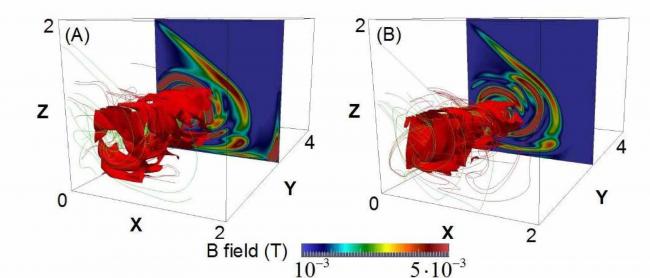An international team, including researchers from the Department of Astrophysics (CEA-Irfu) and Department of Solid State Physics (CEA-Iramis), conducted an unprecedented simulation based on the Von-Kármán-Sodium (VKS) dynamo experiment (CEA-CRS-ENS) [1], to examine more closely how the liquid vortex created in liquid sodium by the propellers of VKS device can generate a magnetic field. The researchers studied the effects of electrical resistivity and fluid turbulence on the generation and collimation of the magnetic field. The detailed modeling shows how a magnetic field can emerge by dynamo effect within a turbulent conductive liquid. These results, published on May 23, 2017 in the journal Physics of Plasma, give to astrophysicists a crucial clue on the generation of magnetic fields within stars or planets.
The dynamo effect consists in the spontaneous generation of a magnetic field from an electric current produced by the massive stirring of conductive liquids. This process is, for example, at work in the heart of stars and certain planets. It follows a mechanism in which a current in a moving fluid produces a magnetic field just as a solid dynamo generates current from the motion of a magnet. In 2007, the VKS collaboration succeeded in showing the possibility of producing this dynamo effect with liquid sodium placed in turbulent rotation. However, there are still areas of shadow in the detailed understanding of this phenomenon. This is why researchers are continuing their experimental efforts and numerical simulations to better understand this dynamo effect.
In the VKS dynamo experiment, two turbine blades on either side of a cylinder filled with liquid sodium create turbulence that can generate the magnetic field. While previous numerical simulations of the dynamo effect with sodium provide only results with limited spatial resolution at the blade level, the current study is the first to model, at high resolution, near turbines, the flow of sodium inside the VKS dynamo.
By simplifying the geometry of the aircraft, researchers carried out targeted magnetohydrodynamic simulations to understand how the turbulence and characteristics of the liquid and materials in the turbine blades affect the collimation of the magnetic field by giving it a directional character.
"The helical flow between the turbine blades creates a collimation of the magnetic field, which facilitates the mechanism of the dynamo effect in the device" said lead author Jacobo Varela, a researcher in the Department Of Astrophysics of the CEA-Irfu when he carried out this work. "In addition, we have found that when the turbine blades are made of ferromagnetic materials, the collimation of the magnetic field is enhanced" he added. On the other hand, numerical simulation shows that the use of conductive materials weakens the collimation of the field. This discovery explains why the dynamo effect in VKS experiments is more easily obtained when using soft iron turbines rather than copper or steel.

3-D view of the vortex and magnetic field lines in the simulation for ferromagnetic (left A) and conductive (right B) boundary conditions. In red is superimposed an iso-surface of the magnetic field at 0.002 Tesla vs 0.0008 Tesla, demonstrating the much higher field amplitude induced in the ferromagnetic case via a stronger vortex collimation. Credit: Varela / Brown / Dubrulle / Nore
The researchers also showed in the simulation that, as turbulence increases, the magnetic field moves from a stable state to a state with periodic inversions, such as those observed in some stars. The magnetic field of the Sun, for example, changes polarity approximately every 11 years, which is the conjugate product of the internal turbulence and its speed of rotation.
Varela and his colleagues at the University of Paris continue to develop the numerical model to reflect the real geometry of the experiment. They plan to add additional parameters, such as the shape of the blades and the background magnetic field, in order to be able to simulate more accurately its performances and to test the means of optimizing the machine. As Jacob Varela points out: "Experimental observations combined with the simulation data will now give us a better understanding of field dynamo generation in stars and other astronomical objects with a liquid and conductive heart like some planets."
Contact : Allan-Sacha BRUN
Publication :
« Effects of turbulence, resistivity and boundary conditions on helicoidal flow collimation: consequences for the Von-Kármán-Sodium dynamo experiment »
by Jacobo Varela (1), Sacha Brun (2), Bérengère Dubrulle (3) and Caroline Nore (4)
(1)Oak Ridge National Laboratory, (2) LIMSI, CNRS, Univ. Paris-Sud, (3) AIM-DAp IRFU (CEA/CNRS/University of Paris 7), (4) SPEC/IRAMIS/DSM, CEA, CNRS, University Paris-Saclay).
To be published in Physics of Plasma, Mai 2017 (DOI: 10.##/1.##).
For an electronic version :  Varela_etal 2017_PoP.pdf
Varela_etal 2017_PoP.pdf
See also : - the CEA Press release (23 May 2017- in French)
- the Physics of Plasma Press release (23 May 2017)
[1] The « Von Karman - Sodium » (VKS) experiment started 10 years ago at the CEA center in Cadarache, in the Nuclear Energy Department of the Nuclear Technology Department, an expert on the handling of metallic fluids such as sodium. The VKS experiment, the result of a collaboration between the CEA, the CNRS and the ENS in Lyon and Paris, made it possible to observe the generation of a spontaneous magnetic field by dynamo effect in a container filled with liquid sodium. It then enabled to detect in the the laboratory spontaneous magnetic field inversions similar to those observed on Earth. In January 2017, the journal Physical Review Letters classified the article describing this result as one of its most outstanding publications over the last 10 years
Content : DCOM CEA / J.M. Bonnet-Bidaud
• Institute of Research into the Fundamental Laws of the Universe • Department of Astrophysics (DAp) // UMR AIM
